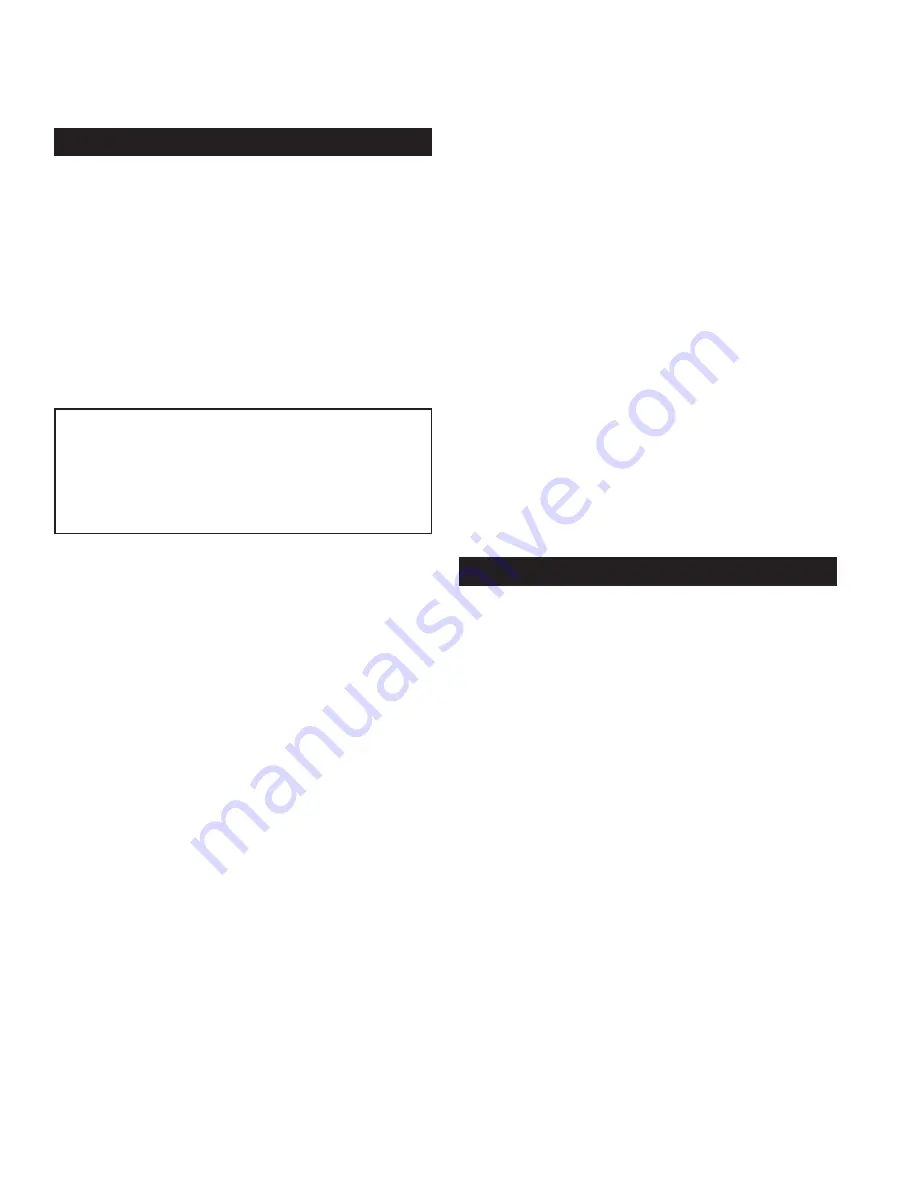
c. Braze the liquid line to the service valve. Allow the ni-
trogen to keep flowing when brazing the refrigerant
line until all brazed joints are completed.
d. Carefully remove the rubber plugs from the evaporator
liquid and vapor connections. Use caution as the
evaporator is pressurized.
e. At a convenient location in the liquid line, install and
braze a biflow filter drier (Sporlan #HPC-103-C or simi-
lar).
f. Braze the liquid line to the evaporator liquid connection
g. Braze the vapor line to the evaporator vapor connection
h. Provide a heat sink to the vapor line service valve of
the heat pump unit
i. Braze the vapor line to the service valve
When tubing installation is completed, seal openings around
5.
tubing where tubing enters the unit cabinet.
Standard refrigeration piping practices must be employed
6.
when installing traps. When installing the condenser be
-
low the evaporator, the suction line must be trapped with
an inverted trap the height of the evaporator coil. Consult
the factory when total equivalent length of refrigerant lines
exceed 50 ft.
Leak checking of refrigerant line braze joints and evapora-
tor unit using dry nitrogen.
Install service port cap of the vapor line service valve (cap
1.
was removed for brazing operations).
Connect dry nitrogen source to the service port of the liquid
2.
line service valve. Pressurize refrigerant lines and indoor
coil to approximately 100 PSIG.
Check for leaks using a liquid soap solution. If any leaks are
3.
located, purge the nitrogen, repair the leak(s) and repeat
the leak check procedure.
Leak checking of refrigerant line braze joints and evapora-
tor unit using R-22 refrigerant.
Connect R-22 source to the service port of the liquid line
1.
service valve. Use of a manifold gauge set will facilitate
connecting and disconnecting of the refrigerant source for
leak checking. Pressurize refrigerant lines and indoor coil
with refrigerant gas.
Leak check with a electronic leak detector or liquid soap so-
2.
lution. If any leaks are detected, use a refrigerant recovery
system to remove the refrigerant. Repair the leak(s) and
repeat the leak check procedure.
Step 2 - Installing Refrigerant Lines
30” clearance is required for service accessibility on the inside.
If more than one unit is to be installed in the same area a min.
of 48’’ vertical must be maintained between units to minimize
recirculation of condenser exhaust air.
Important:
The outdoor unit is fully charged at the factory for the recom
-
mended model of indoor unit. With other models of indoor units
the charge must be adjusted. Be sure both service valves are
closed during tubing installation and leak checking to avoid loss
of charge.
A biflow liquid filter drier must be installed in the
liquid line (SPORLAN #HPC-103-C or similar)
.
The unit has internally mounted service valves. Field tub-
1.
ing may be routed through the locations provided in either
the top or rear flange. Care should be taken not to block ac
-
cess to internal components. Seal unused knockouts with
high grade sealant. Gaskets are provided for liquid and
suction lines.
NOTE:
Always use refrigeration grade copper tubing that
is internally clean and dry for refrigerant lines. Use clean
hard drawn copper tubing if no appreciable amount of
bending is necessary. If soft copper is used, avoid sharp
bends which may cause a restriction. Always use heat
sink materials during brazing to prevent damage to service
valves (
see Figure 1
).
Run refrigerant lines as directly as possible. Field piping in
-
2.
side the heat pump should not block access to major com
-
ponents. Refrigerant lines should not be in direct contact
with the floor or ceiling joists. Use insulated or suspension
type hangers. When refrigerant lines run through a wall,
seal openings around the lines with a flexible material to
avoid vibration to the structure.
Insulate the vapor line with a minimum 1/2” foam rubber or
3.
other type insulation having an adequate vapor barrier.
For
indoor units with a TXV, a liquid line filter drier must be
installed (SPORLAN #C-083-S or similar)
.
Caution: Dry nitrogen should always be supplied through
the tubing while it is being brazed, as the high temperature
required for brazing will cause oxidation of the copper un-
less an inert atmosphere is provided. The flow of dry nitro-
gen should continue until the joints have cooled. Always
use a pressure regulator and safety valve to ensure that
only low pressure nitrogen is introduced into the tubing.
Only a small flow is necessary to displace air and prevent
oxidation.
Install the refrigerant lines using the following procedure
4.
(
see also: Figure 1
).
a. Remove the service port caps and Schrader Cores of
the liquid line service valve and the vapor line service
valve of the heat pump unit. Connect low pressure dry
nitrogen to the liquid line valve service port.
b. Provide a heat sink at the service valve such as
wrapping a wet rag around it, to prevent damage
during the brazing operation
Step 3 - Leak Checking
2


































